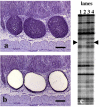Identification of differentially expressed genes in ileal Peyer's patch of scrapie-infected sheep using RNA arbitrarily primed PCR
- PMID: 18373840
- PMCID: PMC2322967
- DOI: 10.1186/1746-6148-4-12
Identification of differentially expressed genes in ileal Peyer's patch of scrapie-infected sheep using RNA arbitrarily primed PCR
Abstract
Background: In scrapie and prion diseases, the knowledge concerning genes involved in host response during the early infection period in the lymphoid tissues, still remains limited. In the present study, we have examined differential gene expression in ileal Peyer's patches and in laser microdissected follicles of sheep infected with scrapie.
Methods: Ileal Peyer's patches and laser microdissected follicles were of scrapie and control lambs with susceptible genotypes for classical scrapie. Potential regulated genes were found using RNA arbitrarily primed polymerase chain reaction (RAP-PCR) and fingerprinting. The differentially expressed genes were confirmed using real-time RT-PCR.
Results: The expression of three genes (MAPRE3, LOC729073 and DNAJC3), were found to be significantly altered in scrapie infected lambs (P < 0.05).
Conclusion: The three genes have not previously been associated with prion diseases and are interesting as they may reflect biological processes involved in the molecular pathogenesis of prion diseases.
Figures


Similar articles
-
Increased PrP mRNA expression in lymphoid follicles of the ileal Peyer's patch of sheep experimentally exposed to the scrapie agent.J Gen Virol. 2007 Jul;88(Pt 7):2083-2090. doi: 10.1099/vir.0.82791-0. J Gen Virol. 2007. PMID: 17554044
-
Age, scrapie status, PrP genotype and follicular dendritic cells in ovine ileal Peyer's patches.Res Vet Sci. 2012 Oct;93(2):853-6. doi: 10.1016/j.rvsc.2011.09.002. Epub 2011 Oct 2. Res Vet Sci. 2012. PMID: 21962485
-
cDNA representational difference analysis of ileal Peyer's patches in lambs after oral inoculation with scrapie.Biochem Biophys Res Commun. 2004 Mar 26;316(1):272-9. doi: 10.1016/j.bbrc.2004.02.040. Biochem Biophys Res Commun. 2004. PMID: 15003541
-
Distribution of prion protein in the ileal Peyer's patch of scrapie-free lambs and lambs naturally and experimentally exposed to the scrapie agent.J Gen Virol. 2000 Sep;81(Pt 9):2327-2337. doi: 10.1099/0022-1317-81-9-2327. J Gen Virol. 2000. PMID: 10950992
-
The intestinal habitat for organized lymphoid tissues in ruminants; comparative aspects of structure, function and development.Vet Immunol Immunopathol. 1991 Mar;28(1):1-16. doi: 10.1016/0165-2427(91)90038-e. Vet Immunol Immunopathol. 1991. PMID: 1905075 Review.
Cited by
-
Prion protein function and the disturbance of early embryonic development in zebrafish.Prion. 2011 Apr-Jun;5(2):88-92. doi: 10.4161/pri.5.2.16093. Epub 2011 Apr 1. Prion. 2011. PMID: 21628994 Free PMC article.
-
Limited transcriptional response of ovine microglia to prion accumulation.Biochem Biophys Res Commun. 2009 Aug 21;386(2):345-50. doi: 10.1016/j.bbrc.2009.06.030. Epub 2009 Jun 10. Biochem Biophys Res Commun. 2009. PMID: 19523453 Free PMC article.
-
Application of "omics" to prion biomarker discovery.J Biomed Biotechnol. 2010;2010:613504. doi: 10.1155/2010/613504. Epub 2010 Mar 4. J Biomed Biotechnol. 2010. PMID: 20224650 Free PMC article. Review.
References
-
- Caughey B, Raymond GJ, Callahan MA, Wong C, Baron GS, Xiong LW. Interactions and conversions of prion protein isoforms. Adv Protein Chem. 2001;57:139–169. - PubMed
-
- Detwiler LA, Baylis M. The epidemiology of scrapie. Rev Sci Tech. 2003;22:121–143. - PubMed
-
- Jeffrey M, Gonzalez L. Pathology and pathogenesis of bovine spongiform encephalopathy and scrapie. Curr Top Microbiol Immunol. 2004;284:65–97. - PubMed
Publication types
MeSH terms
Substances
LinkOut - more resources
Full Text Sources

